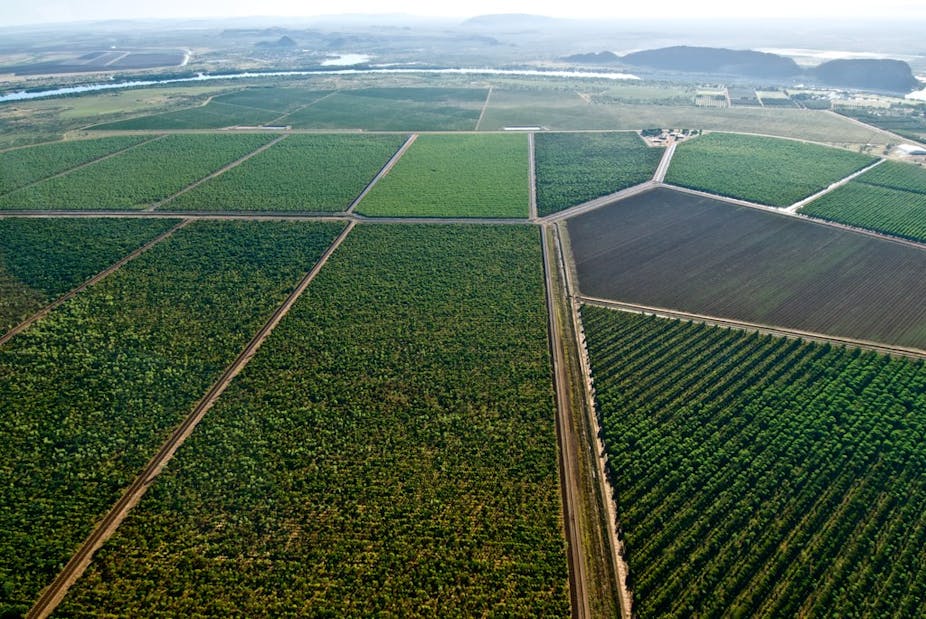When we talk about greenhouse gases we usually talk about carbon dioxide. When media reports depict climate change, we invariably see the cooling towers of a coal power station.
Which is fair, because carbon dioxide, or CO2, is the big one: nearly 75% of Australia’s total greenhouse gas emissions are carbon dioxide. Most of those come from the energy sector and the combustion of fossil fuels.
But there are other gases involved in the greenhouse story. Methane and nitrous oxide are also contributors to Australia’s greenhouse gas account. And both have a much greater impact on the atmosphere in terms of global warming than carbon dioxide.
Carbon dioxide is the currency of climate change and, in those terms, one tonne of methane emitted to the atmosphere (for example from livestock) is equivalent to 34 tonnes of carbon dioxide emissions. One tonne of nitrous oxide is equivalent to 298 tonnes of carbon dioxide.
Nitrous oxide has an atmospheric lifetime of 110 years. The process that removes nitrous oxide from the atmosphere also depletes ozone. So nitrous oxide is not only a greenhouse gas, but also an ozone destroyer.
Nitrous oxide (or N2O), is more commonly known as laughing gas. But the nitrous oxide in the atmosphere doesn’t come from dentists — it comes from nitrogen-based fertilisers.
Globally, about 1% of all the nitrogen fertiliser applied to the soil to grow our food is emitted to the atmosphere as nitrous oxide. In Australia, that 1% is actually more like 0.5%.
Yes, it is a very small number, but it means a lot in terms of a farmer’s impact on global warming.
It’s not just about climate
Nitrous oxide is not just a greenhouse gas, it is a very good indicator of a grower’s efficiency in his farming practices and how he manages the nitrogen he applies to his crop.
For every kilogram of nitrous oxide emitted, there are other nitrogen gases (e.g. di-nitrogen or N2) that are lost in far greater amounts, from 2-70 kilograms. These other gases have no impact on our atmosphere (which is already 78% di-nitrogen), but they are equivalent to lost production and ultimately lost income to a farmer.
Nitrogen fertiliser is not cheap. Every tonne of nitrogen costs the grower more than A$1,000, but it is critical for meeting the demands of a rapidly growing world population.
Australian farmers collectively apply nearly 1 million tonnes of nitrogen every year. If (conservatively) 25 kilograms is lost to the atmosphere for every tonne applied, that is A$25 million dollars each year shaved off the economy.
Sustainable farming is fighting climate change
Australian farmers are now more productive and efficient than ever before, and in many cases are applying more nitrogen fertiliser to meet the demands of growing bountiful crops. At the same time, by choosing the right time to fertilise, more of the nitrogen will end up in the crop and not the air.
“Increasing nitrogen use efficiency” is the terminology commonly used in the agricultural sector and is paramount to sustainable agriculture from multiple points of view — productivity, profitability and environmental sustainability.
By following the basics of sustainable farming and building up their native supply of nitrogen in soil organic matter, or using legumes (a free source of atmospheric nitrogen), growers are reducing their reliance on nitrogen fertilisers and reducing their greenhouse gas emissions.
None of these actions are new. They are being practised by the majority of growers in Australia.
This is not to say we should take our hands off the wheel. It is still early days, with some regions and industries faring better than others. For example, the semi-arid cropping areas have extremely low emissions of nitrogen compared to the high-rainfall cane-growing regions.
From an economic and environmental sustainability point of view, rural industries and government must continue to invest in this space.
Historically, farmers the world over have been viewed as insensitive to their environment. But the principles of sustainable agriculture and feeding a growing population are in sync with reducing climate change.

